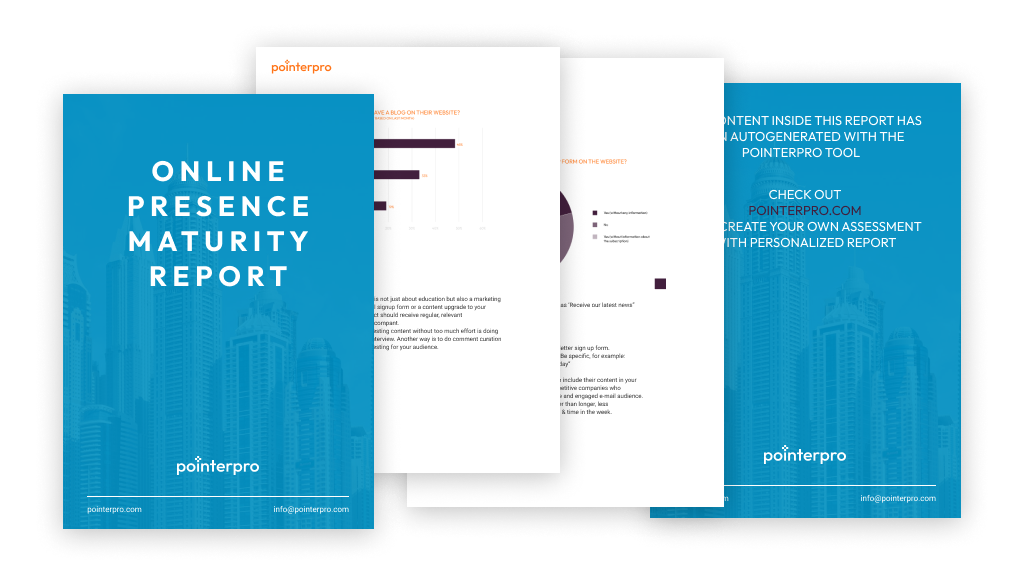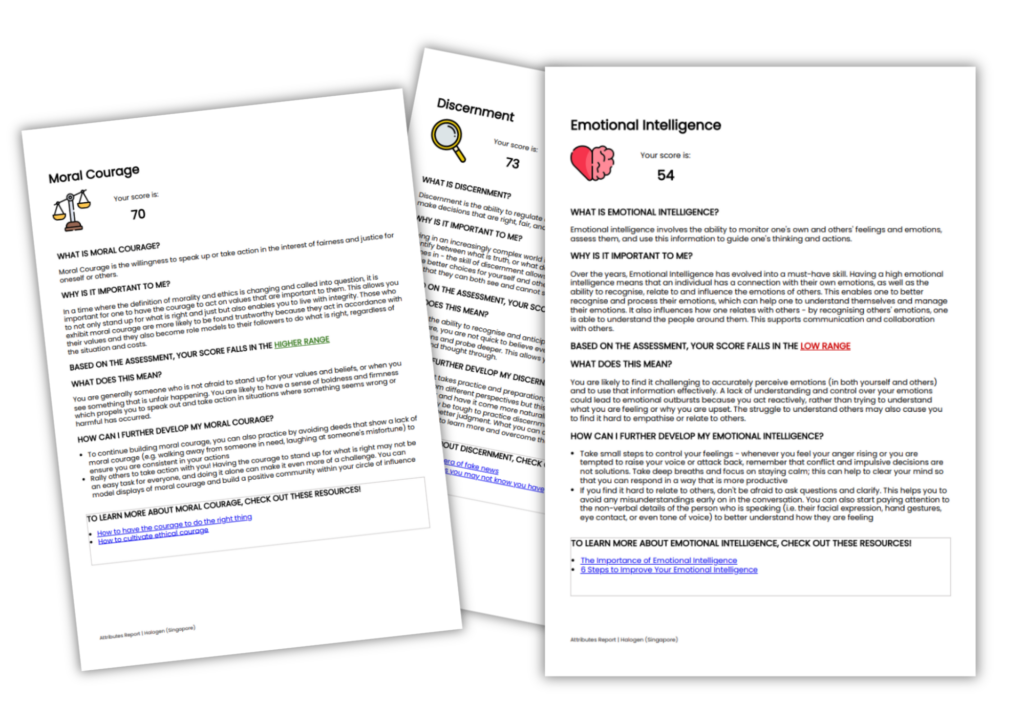Jeff is an ex-serial entrepreneur. In the 1990s, whenever he’d launch a business idea, sooner than later, there would be a thriving company in the region. He was a man with a reputation. Twenty-some years ago, he took up the habit of coaching young entrepreneurs. He quickly became the go-to guy for anyone who considered starting a company. Another booming business, JeffCoaching, was born.
But ten years ago, things started to change. Young entrepreneurs stopped knocking on Jeff’s door. Most people with a zeal for entrepreneurship would onboard with AmbitionCompass Inc instead.
The difference between JeffCoaching and AmbitionCompass? Online presence. As good of a coach and entrepreneur as he is, Jeff would score poorly on Pointerpro’s online presence maturity assessment we launched a few years ago.
Some key findings of that assessment show there’s room for improvement for many participating companies in real life as well:
- 39% of respondents report not including interactive content on their website
- 46% of the companies or their CEO contribute more than once per month on LinkedIn
- 38% publish two or more blog posts per month
- 41% don’t have customer quotes on their homepage
Why does this all matter? Let’s try to fully understand what it entails.
Online presence definition (what is online presence?)
Your online presence is your footprint in the vast Darwinian world of the Internet. The average internet user spends 6 hours and 56 minutes online each day, according to the Digital 2021 April Global Statshot Report. That’s almost 49 hours per week and about 2,500 hours per year!
In a world like this, making the most of your business’s digital presence and cutting through the online noise from time to time is your best bet.
It implies, at a very minimum, including videos and interactive content on your website, buffing up your blog with online content as well as your social media presence, actively posting customer testimonies, keeping your domain authority above your competition, and more.
This takes time and persistence, but it’s worth the effort, as you’ll find out.
The importance of your digital presence
Step into your potential customers’ shoes for a moment. They are in need of a service to solve a problem. But before they decide they have a problem, there’s at least a lingering question on their mind, to which they want an answer. The internet is where they go to find it (where else, given that they’re on it almost 7 hours per day, right?).
This is where digital presence comes into the equation. You need to occupy some digital real estate and gain your potential customer’s trust. Your online presence should at least demonstrate to your potential customers who you are as a company, what mission and values you stand for, and what makes you worth interacting with.
Your potential customers have questions, remember. Use your digital presence to show them that you’ve got the answers. More so, than competitors.
So, how does your online presence stack up against the benchmark? Time to dive into our State of Online Presence Report.
Study method
We’ve analyzed 378+ websites of midsize professional services companies using a 10-question maturity assessment based on the following:
- If the business has a blog on their website
- If there is a newsletter signup form on the website
- If the website contains information about its key people
- If there are one or more customer quotes on the homepage
- If the website contains interactive content
- If the CEO (and the company) have an active presence on LinkedIn
- The websites’ Domain Authority score
- The contact options available on the website
- The website’s speed score
- If the website contains video content
The multiple choice answers each corresponded to a score between one and 10. The total score was out of 100.
Study results
So, just how well are these businesses doing with their online presence?
1. Blogs with benefits
Most of those working in online marketing know they need blogs to help guide their potential customers down the sales funnel. Hubspot reported in their blog article (updated in May 2022) that B2B marketers who use blogs, receive 67% more leads than those who do not.
So how many websites are frequently posting on their blogs?
We found that 38% of the websites in the study have more than two blog articles published within the last month, whereas 42% have blogs published, but less than two posts during that period of time. However, 20% reported having no have a blog on their website.
Makes you wonder if our friend Jeff had a blog, doesn’t it?
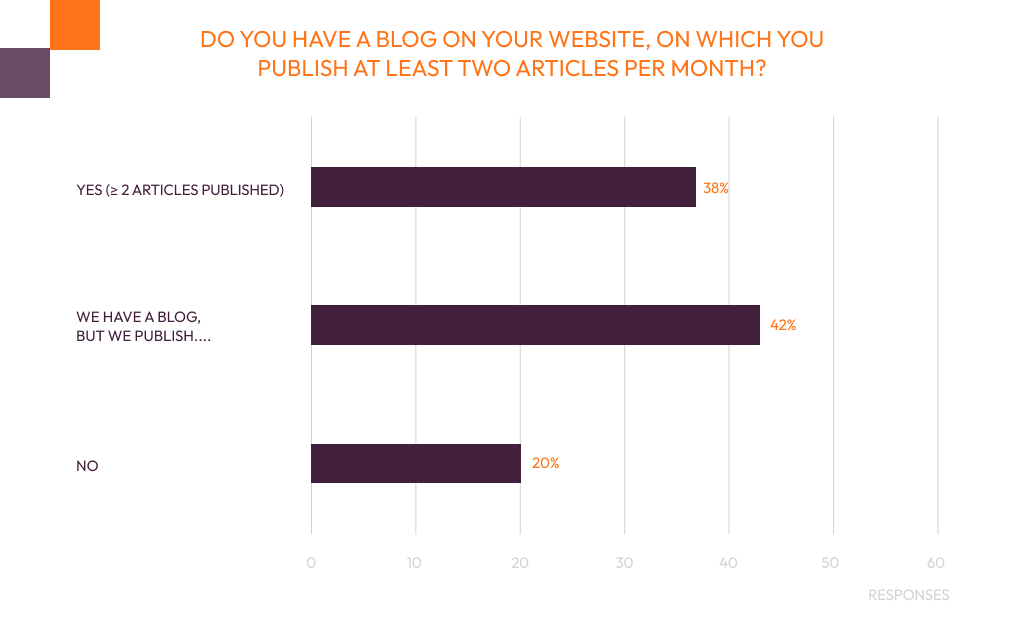
2. Newsletters (and what's in it)
Newsletters – especially e-newsletters – are another important tool that 83% of B2B companies use as part of their content marketing program, according to HubSpot in 2022. The article adds that 40% of these marketers would even go as far as to say email newsletters are the most “critical” component of their content marketing success, also according to HubSpot.
Our study found that 36% of the businesses include a newsletter signup form on their website, but without any information about the subscription. 35% of these websites have a form with some more information about what people will get when they subscribe, whereas 29% didn’t even include a form.
Do you let your website visitors know what’s in it for them, to subscribe to any of your information sharing channels?
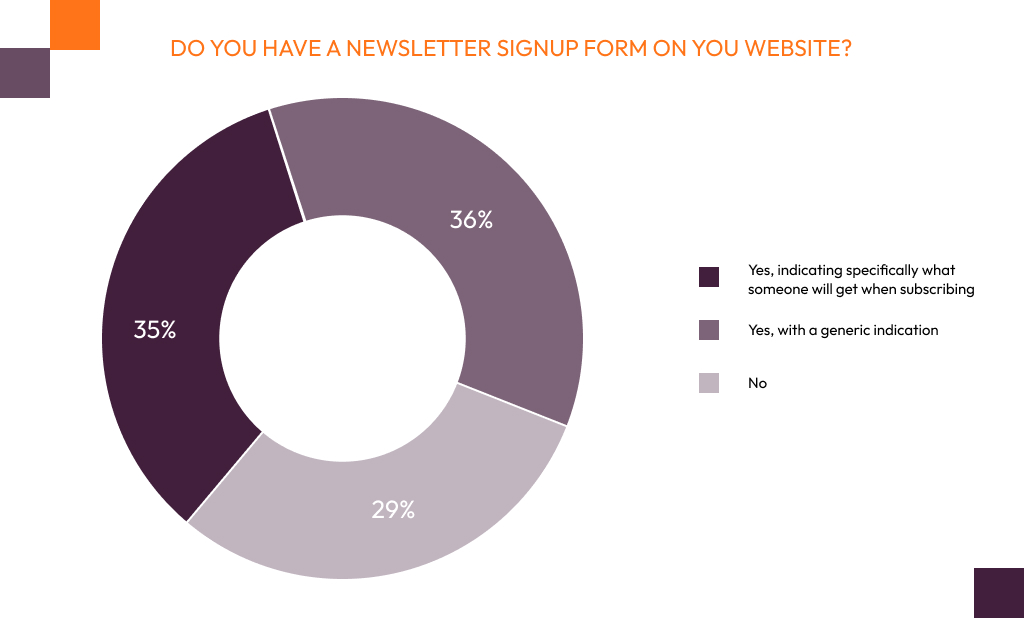
3. Information about key people
Remember, you are trying to build up trust from your potential customers. Without that basic instinct, there is no way they will convert into actual customers.
We live during a time when people want to know about the businesses where they are investing their money. Customers want to feel good about the CEO, his or her expertise, and what he or she believes and supports.
Our online presence analysis shows that 54% of the websites include the first and last name of the key people there, and 55% include a photo. 56% include a short bio, but only 28% include a link to their LinkedIn profiles. 12% of the websites include none of this information.
Today’s world might have a strong virtual component to it, but that doesn’t mean people don’t still buy from people. Being digital doesn’t imply you stop being human. Keep that in mind.

4. A customer quote a day, keeps the doubts away
Your business is the best one there is in your field of expertise, you say? Hey, we know how you feel – we feel we’re doing not so bad ourselves, either. We believe you. But don’t forget, we live in a time of savvy consumers.
Most customers will not make a purchase unless they first read reviews. This isn’t bound to change anytime soon. According to last year’s ReviewTrackers study, review interaction is up by 50% from pre-pandemic levels.
While your savvy customers will most likely research reviews from all over, make sure to also provide reviews in the form of customer quotes on your website.
A fairly balanced result from our assessment: 21% of the websites have no customer quotes on their homepage. 26% include customer quotes with little information about the author, 20% include them but not on the homepage, and only 33% include the quotes on the homepage with the author’s title, company and picture.

5. Interactive content is not radioactive: go for it
79% of marketers reported to TopRank that combining interactive content with their other content marketing tactics increased message retention. We’re not going to contradict that in any way. As a business that focuses on interactive content such as assessments, quizzes, and tests, we believe stronger than anyone in its capabilities.
However, we will tell you this: interactive content is still underutilized. Most of the websites we analyzed (39%) reported having no interactive content at all. 34% has interactive content, but not on the homepage. 27% does include it on their homepage.
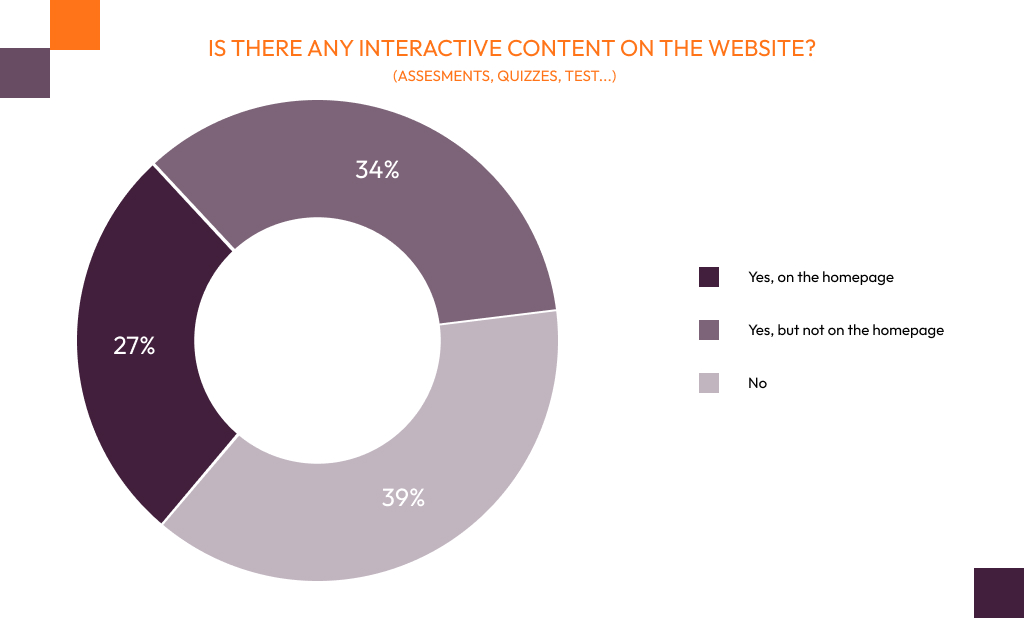
6. (CEO) LinkedIn presence
Once again, you are working in a time of savvy customers who want to invest in businesses that align with what is important to them. That’s why it’s crucial that the company and ideally also the CEO of a B2B company have an active LinkedIn presence.
Our study shows that 46% of companies post on LinkedIn twice or more per month – either on their company’s LinkedIn page or via their CEO’s LinkedIn profile. 27% contributes about once per month, and 28% publishes nothing or less than once per month.
Have you tried finding our friend Jeff’s LinkedIn profile? We bet you didn’t find it. Sure, he’s a fictional character we didn’t even provide a last name for. But you get our point.
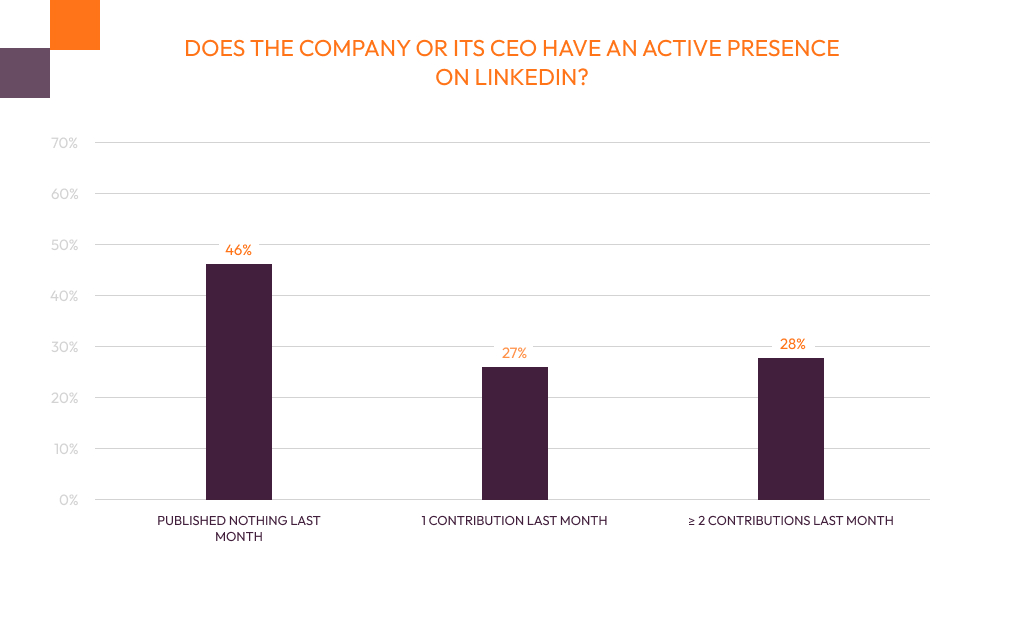
7. Respect the domain authority
Domain authority is a good measure to keep an eye on if you care about your online presence (and we hope by now, you do). But what is domain authority?
According to Moz, domain authority is:
“a search engine ranking score developed by Moz that predicts how well a website will rank on search engine result pages (SERPs). A Domain Authority score ranges from one to 100, with higher scores corresponding to a greater ability to rank.”
Domain authority can be increased by several ways including a solid link building strategy and producing quality content.
We found that the average domain authority for the websites it analyzed was 35. This is a relatively low number, indicating that most companies do not undertake effective efforts to ensure that their website ranks in the search results. A chance for you to stand out? You can start by implementing a solid link building outreach system to build partnerships with reputable websites to increase your DA.
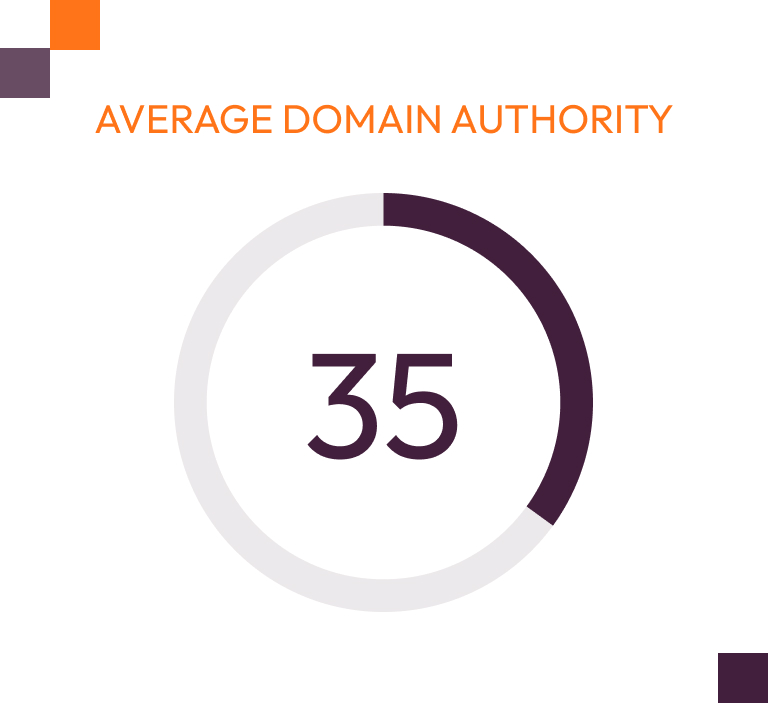
8. Contact is the start of engagement: provide options
Engagement is key when it comes to converting potential customers into actual customers, but when they want to engage with your company, is it easy for them to find a way to do so?
Making sure you have easy-to-find contact information available on your website is crucial to the success of your business. Our study found that 53% of the businesses analyzed have their phone number available, 62% percent have a contact form and 62% included an email customers could use. 26% percent of the websites include a chat feature or chat tool.
3% includes no contact information. We’d love to tell you why. But we had no way to get in touch with them to ask.
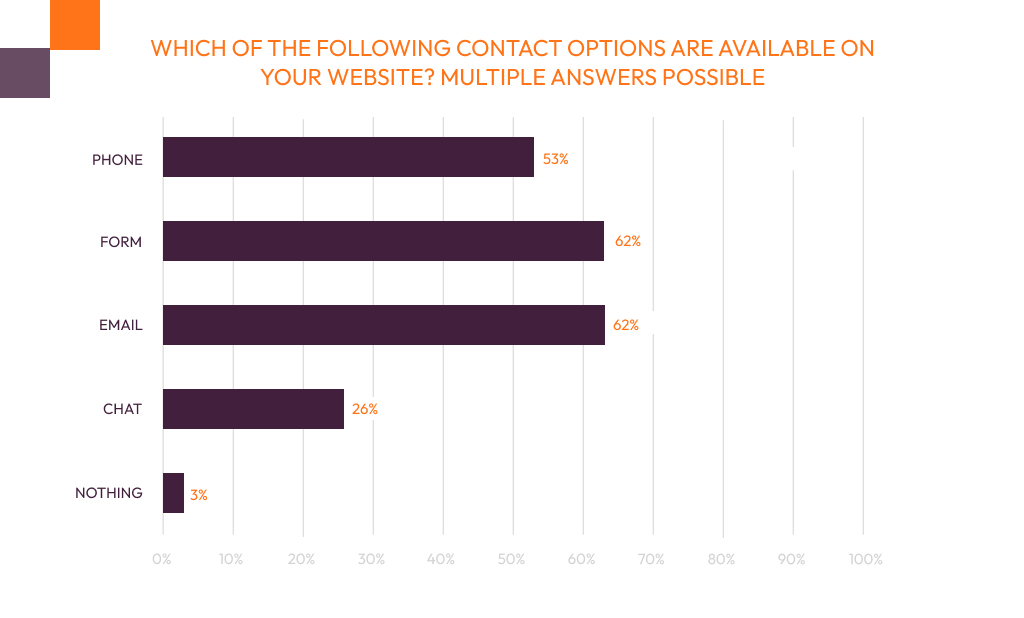
9. Website speed
For most people, time is both our most valuable and most limited resource. There are places to be and people to see! Potential customers simply don’t want to wait for information to load. And given there are so many options available on the internet, frankly they won’t.
According to Think with Google, websites that load in five seconds – compared to ones that load in 19 seconds – see 70 percent longer average sessions. A performance report from Akamai stated that a 100-millisecond delay in load time can cause a drop in conversion rates by up to seven percent.
Our study showed that the average site’s speed score of the analyzed websites was 44 out of 100.
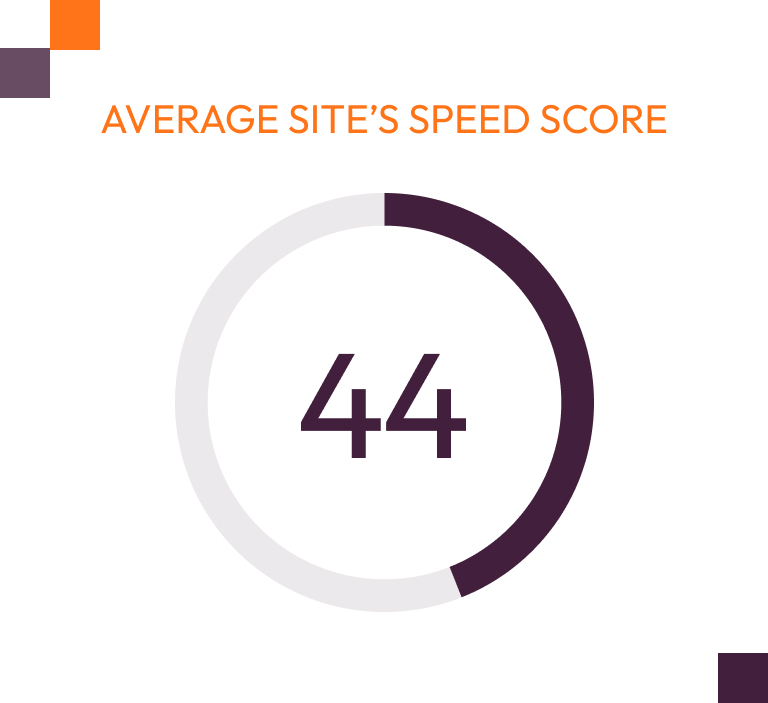
10. Video content: internet is the new television
In the beginning of this article, you read about Jeff from JeffCoaching. You’ll probably agree, he’s a remarkable character. One might even say, the type of person you see appear in a commercial video during on the morning news. But here’s the thing.
People no longer get their news primarily from television, as Pew Research Center reported in the US. More than 80% of adults get their news from a smartphone, tablet or computer. Seemingly, if you’re going to appear in any video, you better make sure it appears online.
Nevertheless, 28% of the websites from our study have no online video content. Less than a quarter – 39% – reported to have video content, but it doesn’t appear on the homepage. 33% of the websites included video content on their homepage.
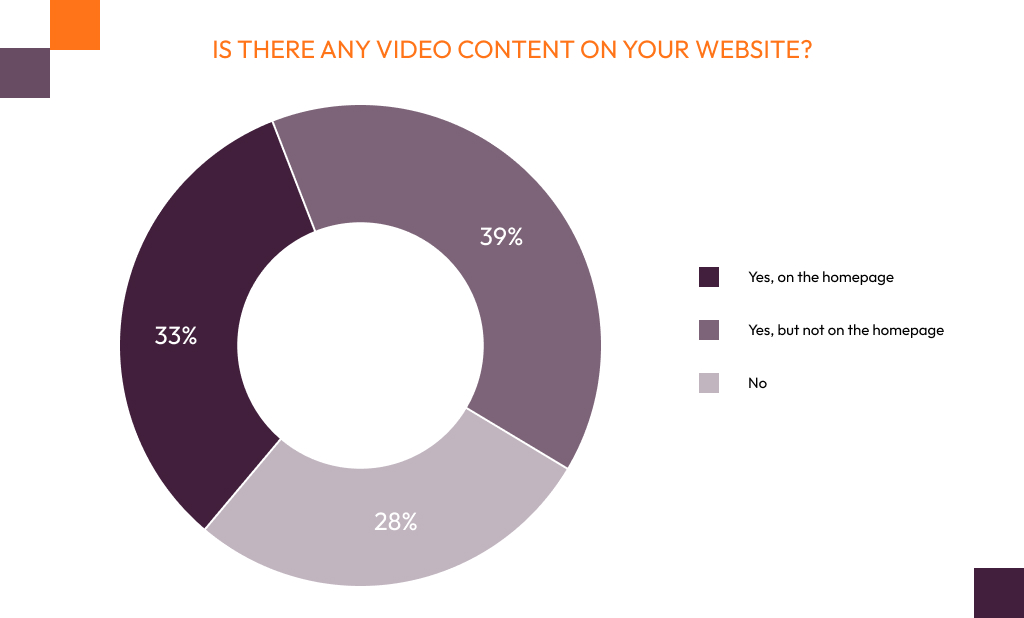
So, how do you think you're doing?
The facts and figures discussed in this article probably give you an idea of where your online presence is at compared to other companies. Don’t shy away from any incremental improvements you can bring about. Your digital presence will help you connect, engage and convert potential customers into actual, loyal customers.
Meanwhile, stay tuned for future online assessments and reports we share.

